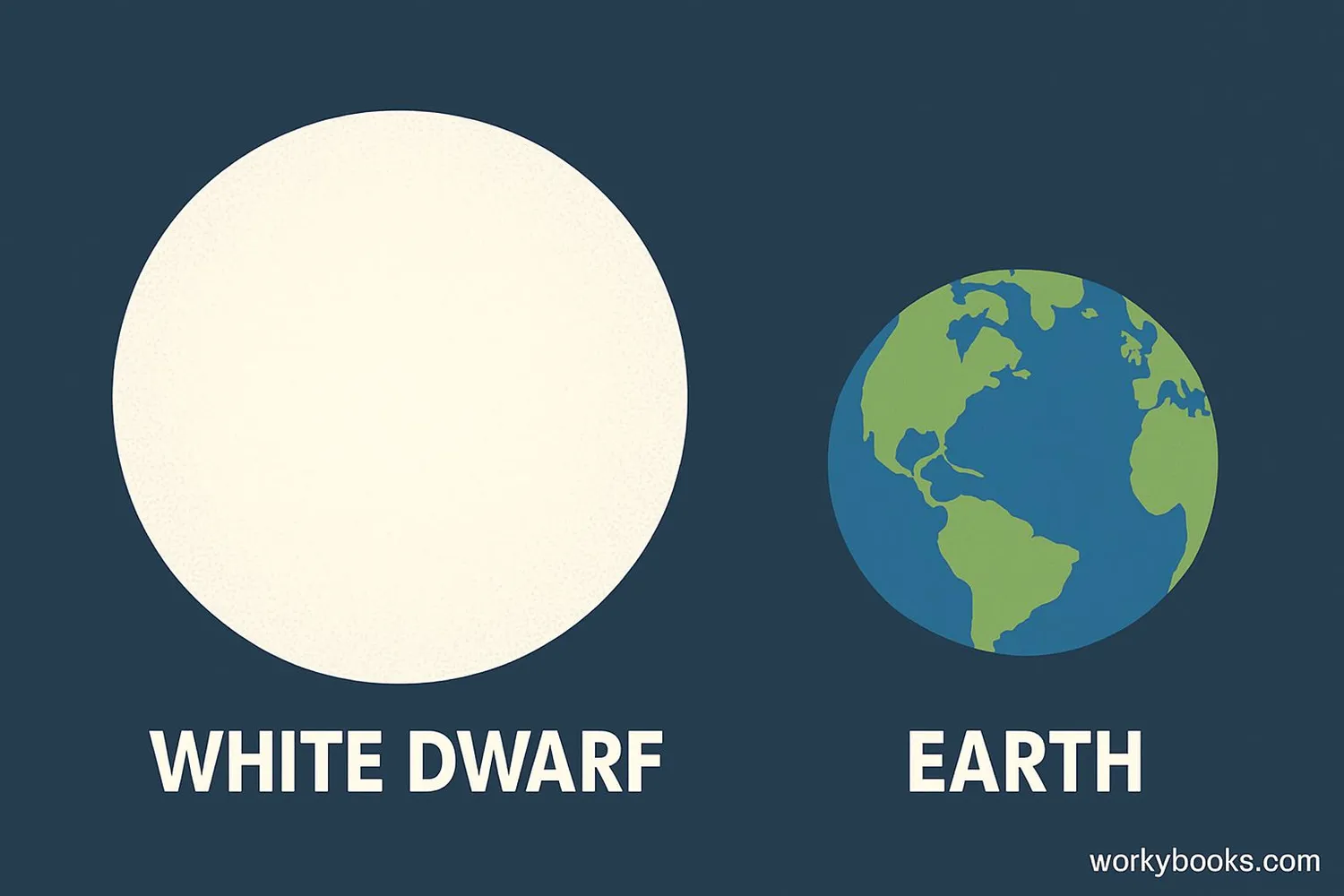White Dwarf Stars - Definition, Examples, Quiz, FAQ, Trivia
Discover the amazing remnants of stars like our Sun
What is a White Dwarf?

A white dwarf is the incredibly dense core left behind when a star like our Sun runs out of fuel. It's what remains after a star sheds its outer layers at the end of its life.
Imagine something with the mass of our Sun squeezed into a sphere the size of Earth! That's how dense white dwarfs are. A teaspoon of white dwarf material would weigh as much as an elephant here on Earth.
White dwarfs are extremely hot when they first form, glowing white-hot with surface temperatures over 100,000°C. But since they no longer produce energy through nuclear fusion, they slowly cool down over billions of years.
Space Fact!
Our Sun will become a white dwarf in about 5 billion years, after it expands into a red giant and sheds its outer layers.
How White Dwarfs Form

White dwarfs form through a beautiful cosmic process:
Star Runs Out of Fuel
A star like our Sun uses up its hydrogen fuel after billions of years
Expands into Red Giant
The star swells to hundreds of times its original size
Sheds Outer Layers
The star ejects its outer atmosphere into space
Planetary Nebula
The ejected material forms a glowing cloud around the star
White Dwarf Remains
The hot core is left behind as a white dwarf
The planetary nebula stage is one of the most beautiful sights in astronomy. These glowing clouds of gas can have amazing shapes like rings, butterflies, or hourglasses. But they don't last long - in about 10,000 years, the nebula fades away, leaving only the white dwarf behind.
The Science Behind White Dwarfs

White dwarfs are held up by some fascinating physics:
Degenerate Gas
Atoms are crushed together so tightly that electrons form a "degenerate gas"
Pauli Exclusion Principle
Electrons resist being squeezed together, creating outward pressure
Chandrasekhar Limit
The maximum mass a white dwarf can have (1.4 times the Sun's mass)
The Pauli Exclusion Principle is a quantum physics rule that says two electrons can't occupy the same space with the same properties. This creates pressure that prevents the white dwarf from collapsing further.
The Chandrasekhar Limit (named after the scientist Subrahmanyan Chandrasekhar) is the maximum mass a white dwarf can support. If a white dwarf gains more mass than this (by pulling material from a companion star), it will collapse further, possibly becoming a neutron star or black hole.
White Dwarf Varieties & Events

White dwarfs can be involved in some spectacular cosmic events:
Cataclysmic Variables
When a white dwarf pulls material from a companion star
Novae
Explosions that occur when accumulated material ignites
Type Ia Supernovae
Complete destruction when white dwarf exceeds Chandrasekhar limit
In cataclysmic variable systems, a white dwarf orbits close to another star. The white dwarf's strong gravity pulls material from its companion. This material forms a hot, spinning disk around the white dwarf before falling onto its surface.
Sometimes, the accumulated material can ignite in a thermonuclear explosion called a nova. This makes the star suddenly brighten by thousands of times for several weeks. Unlike a supernova, the white dwarf survives and the process can repeat.
If enough material accumulates to push the white dwarf over the Chandrasekhar limit, it explodes completely in a Type Ia supernova. These are extremely bright and important for measuring cosmic distances.
White Dwarf Quiz
Test your knowledge about white dwarf stars with this quiz!
Frequently Asked Questions
Here are answers to some common questions about white dwarfs:
White Dwarf Trivia
Discover some amazing facts about white dwarfs!
Incredible Density
A teaspoon of white dwarf material would weigh about 5 tons on Earth - as much as an elephant!
Extreme Temperatures
Newly formed white dwarfs have surface temperatures over 100,000°C - about 18 times hotter than the Sun's surface!
Historical Discovery
The first white dwarf discovered was 40 Eridani B in 1783, but astronomers didn't understand what it was until the early 20th century.
Diamond Stars
Some white dwarfs may crystallize into giant diamonds as they cool! BPM 37093 is a white dwarf that may contain a diamond core weighing 5 million trillion trillion pounds.


